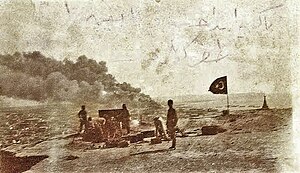
Back معركة باكو Arabic Bakı döyüşü Azerbaijani باکی دؤیوشو AZB Бітва за Баку (1918) Byelorussian Batalla de Bakú Catalan Schlacht um Baku German Μάχη του Μπακού Greek Batalo de Bakuo Esperanto Batalla de Bakú Spanish Bakuu lahing Estonian
| Battle of Baku | |||||||
|---|---|---|---|---|---|---|---|
| Part of the Armenian–Azerbaijani War in the Caucasus Campaign of World War I & Southern Front of the Russian Civil War | |||||||
 Ottoman artillery bombarding the city. | |||||||
| |||||||
| Belligerents | |||||||
|
|
Until 26 July: | ||||||
| Commanders and leaders | |||||||
|
|
Until 26 July: From 26 July: | ||||||
| Strength | |||||||
|
14,000 infantry 500 cavalry 40 guns[1] |
20,000 infantry.[4] 40 guns[1] 1,000 infantry 1 artillery battery 3 machine gun section 3 armored cars 2 Martinsyde G.100 planes[1] 6,000[1] | ||||||
| Casualties and losses | |||||||
|
|
| ||||||
The Battle of Baku (Azerbaijani: Bakı döyüşü, Turkish: Bakü Muharebesi, Russian: Битва за Баку) took place in August and September 1918 between the Ottoman–Azerbaijani coalition forces led by Nuri Pasha and Bolshevik–ARF Baku Soviet forces, later succeeded by the British–Armenian–White Russian forces led by Lionel Dunsterville, and saw Soviet Russia briefly re-enter the war. The battle took place during World War I, was a conclusive part of the Caucasus Campaign, but a beginning of the Armenian–Azerbaijani War. [5][6]
- ^ a b c d e f g Cite error: The named reference
cavenwas invoked but never defined (see the help page). - ^ "Lionel Dunsterville Diary". www.gwpda.org.
- ^ Anastas Mikoyan. Так было. Moscow: Vagrius, 1999; Ch. 2.
- ^
 6,000 regulars
6,000 regulars
Lisa Smedman. Dunsterforce. Vancouver Courier newspaper. - ^ Yale, William (1968) Near East: A Modern History p. 247
- ^ Dadyan, Khatchatur(2006) Armenians and Baku, p. 118